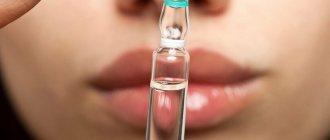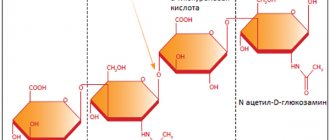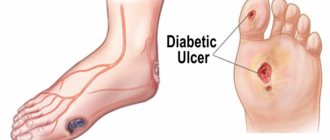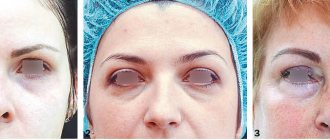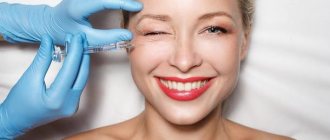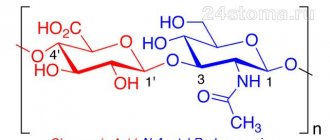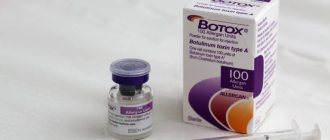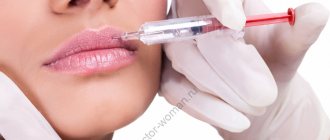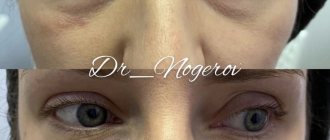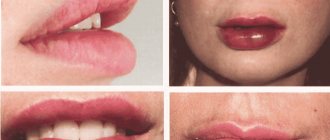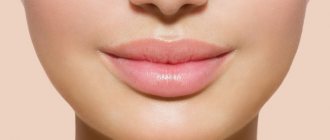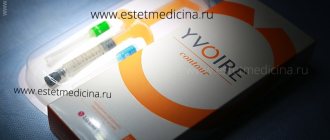Contour plastic surgery is a rejuvenating technique that does not involve surgical intervention. During the procedure, a special drug, a filler, is injected into the deep layers of the skin; its effect can be permanent or temporary. Contour plastic helps eliminate wrinkles, asymmetry of the face and its individual areas, tightens the facial contour, adds volume to some areas, removes scars. Before making an appointment with a cosmetologist, the patient usually wants to know more about the procedure, and we tried to collect the most common questions and give answers to them.
Why does swelling appear after contouring?
The first reason: the body’s natural reaction. Contour plastic surgery is an injection technique, which means that the tissue will respond to the injection as if it were subject to minimal external influence. Puncture of the skin and injection of filler leads to an increased flow of blood cells to the site of damage and acceleration of metabolism. This causes mild swelling, which subsides in 1-2 days. The second reason is the presence of hyaluronic acid in the filler. It increases tissue hydration by attracting a large number of water molecules; this property can explain the appearance of edema.
Benefits of correcting nasolabial folds with fillers
The procedure has the following positive characteristics:
- Safety. Drugs used to correct the nasolabial area are biologically soluble. After the procedure, no scars remain on the face.
- Efficiency. The active substance not only smoothes out wrinkles, but also improves the overall condition of the skin. The procedure allows you to get rid of wrinkles, dryness and other problems that can appear with age.
- Painless. Thanks to the pre-treatment of the skin with an anesthetic, the introduction of fillers into the nasolabial folds causes virtually no discomfort.
- Convenience. The procedure for correcting nasolabial lips with fillers takes on average about half an hour and does not require special preparation. If necessary, it can be combined with other cosmetic procedures.
Is it painful to have contour plastic surgery?
Pain tolerance is an individual thing. The filler is injected into the skin with a microneedle of minimal thickness - this significantly reduces discomfort. And contour plastic surgery of particularly sensitive areas (around the lips, around the eyes) is performed under local anesthesia.
How to prepare for contour plastic surgery?
You should first visit a cosmetologist, he will provide individual recommendations for you. General recommendations for most patients are:
one week before the procedure:
- Avoiding blood thinners will help prevent swelling and bruising.
per day:
- refusal to drink alcohol.
- ban on visiting the bathhouse/sauna
- ban on thermal procedures in the facial area,
- refusal of intense training.
When will the results of plastic surgery be visible?
Contour plastic surgery is also attractive because the result of the procedure can be assessed immediately after it is performed. However, do not forget that during the first days you may experience swelling and irritation of the skin. To evaluate the final result, you should wait 1-2 days - during this time the tissues will adapt to the injected filler and its components will begin to produce the expected effect. How pronounced it will be depends on several factors:
1. type of drug,
2. volume injected,
3. experience and skill of the cosmetologist performing the procedure.
A doctor who has extensive practical experience in performing contouring knows how much to administer the drug depending on the area being corrected and achieves a lasting positive effect.
Common Complications
All complications that arise after the introduction of fillers in cosmetology can be divided into the following groups:
- By time of occurrence: immediate or delayed reaction (Table 1)
; - Aesthetic significance: local or general;
- Reason for side effect:
- Reaction at the injection site;
- Reaction to incorrect administration;
- Allergy or hypersensitivity;
- Vascular reactions.
Table 1. Side effects depending on time of occurrence
| Early (from several days to several weeks) | Delayed (from several weeks to several years) |
Injection site reactions:
| Granulomatous inflammation |
Allergic reactions/hypersensitivity:
| Nodules, inflamed or not |
| Lumps formed by improperly distributed drug under the skin | Migration of the injected filler |
| Tissue necrosis | Scars |
| Embolism | Asymmetry |
Injection site reactions
Swelling, redness, bruising, pain, itching and infection may occur at the site of the skin piercing. Swelling and bruising are considered normal and usually go away within a few days. They can be reduced by applying pressure to the injection site and applying an ice compress to it. In addition, you must stop taking medications that prevent blood clotting. Rare cases of recurrent spasmodic tumors appearing after drinking alcohol, exposure to the sun or excessive physical activity have also been reported. This effect can last for years.
Infections are rare and present as one or more inflamed nodules that are treated with antibiotics. Some experts suggest that this kind of inflammation is the result of the action of bacteria (for example, staphylococcus or propionic acid) on the surface of the biofilm around the filler. Therefore, injections are not performed in areas affected by infections. There is no evidence that fillers provoke a recurrence of the herpes virus, however, for those for whom “fever” on the lips is a frequent occurrence, it would not hurt to use an antiviral agent.
Incorrect introduction
Cases where the filler is clearly visible under the skin are the result of incorrect injection technique. Depending on the type of product (especially hyaluronic acid fillers), small nodules or blue spots may form under the skin. The latter are formed due to hemosiderin (an insoluble protein) produced during interstitial bleeding. Small nodules are treated with local massage, suctioning, or incision followed by drainage. Hyaluronidase is used to destroy nodules or the filler itself, visible under the skin. Hyaluronic fillers require a preliminary skin allergy test.
If the Artecoll filler is not injected deeply enough, constant itching, redness and even hypertrophied scars may occur. The defects caused by hyaluronic fillers can be reduced with local corticosteroid injections. Superficial injection of Radiesse fillers will result in the formation of white bubbles under the skin; they need to be punctured and the contents squeezed out. Injecting silicone directly under the skin will result in fibrosis and granulomas, nodules and textural changes. Granulomas and scars may occur over a period of three weeks to several years.
Accidental intramuscular injections of fillers (with the exception of preparations based on hyaluronic acid and collagen) will inevitably lead to their migration and the formation of unwanted lumps and compactions. For the same reason, Radiesse injections are not given into the lips: constant contractions of the annular muscle provoke the formation of subcutaneous nodules.
Allergy and hypersensitivity
Depending on the drug administered, various reactions occur.
- Collagen.
In 1.3% of cases, bovine collagen may be immunogenic. Within 10 days after the first injection, there is a possibility of formation of erymatous, compacted nodules under the skin. About 1-3% of patients may still experience a negative reaction to the filler, even if the skin test is negative. Therefore, it is recommended to do 2 bovine collagen allergy tests with an interval of 3-4 weeks. If these symptoms do not go away on their own, they can be easily relieved with oral glucocorticoid hormones. - Hyaluronic acid fillers.
A reaction to a filler injection can occur either a month or years after the injection. Such phenomena are usually asymptomatic; in some cases, hyaluronic fillers cause erythema and swelling. They are treated with local corticosteroid injections. The dosage depends on the severity of the lesion; if necessary, injections are repeated after 4-6 weeks. Some practitioners use hyaluronidase in the hope that its breakdown will reduce side effects. - Poly-L-lactic acid
. During clinical studies, 3-4 months after injections (sometimes the period is reduced to 1 month). Sometimes the injection of fillers is accompanied by the appearance of nodules on the skin. They can be easily felt, but not visible. The exact nature and mechanism of their formation have not been established, but to avoid them, filler injections must be done under the dermis.
Vascular reactions to filler injections
Skin necrosis as a result of compression or blockage of blood vessels is a rather rare consequence. Most often it occurs in the region of the glabella, where there is no auxiliary blood circulation. Sometimes cases of ischemia and necrosis occur in the nasolabial area, due to the anatomy of the vessels in this area. To avoid such complications, it is recommended to use lighter fillers for contouring, inject them slowly, constantly moving the needle. Injecting your own fat can cause the same side effect. This can be avoided by introducing the required volume of filler for contouring in several sessions.
Up to what age can contour plastic surgery be done?
This procedure does not have strict age restrictions. Contour plastic surgery with fillers can be performed for patients of any age. Differences may only affect the technique of administering the drug, the type and volume of filler.
Biopolymer gel or gel based on hyaluronic acid: which is better?
Facial contouring using biopolymer gel is already a thing of the past. The fact is that this substance is of synthetic origin; it does not dissolve in tissues. The advantage of the biopolymer gel was its low price and long-lasting effect (more than 5 years). However, it was abandoned due to the high risk of complications. It caused inflammation, swelling, and could migrate to nearby areas, causing deformation of the contours of the face. Fillers with hyaluronic acid are more expensive, but much safer. They take root well, do not cause inflammatory processes, and are removed from tissues naturally, since they are based on a natural component of the human body. The effect of contouring with hyaluronic acid preparations is predictable, and the procedure itself is less traumatic for the body.
Elimination of complications
Severe swelling and allergic reactions caused by injectable fillers can be treated with oral corticosteroids or antihistamines.
Bubbles and bumps caused by contour fillers should resolve on their own. If this does not happen, the injectable fillers are removed by cutting and draining the tissue. Permanent compounds can be removed using local corticosteroid injections, surgical incisions, dermabrasion, or laser resurfacing. Blisters on the upper lip are eliminated with massage, incision and drainage, local hormone injections, or surgery.
As a rule, pain and discoloration of the injection site are the result of blockage of blood vessels. In such cases, you should immediately apply a warm compress, massage and apply nitroglycerin paste. If hyaluronic filler was used, hyaluronidase is injected to destroy it and relieve tension in the tissues.
What effect is achieved as a result of contour plastic surgery?
The active substance, which is injected into the deep epidermal layers during the procedure, not only removes wrinkles and refreshes the face, but also helps maintain hydrolipid balance and skin tone. Even after the natural removal of the drug, the nasolabial folds remain less pronounced than they were before the procedure.
The visible effect after contouring lasts for a period of six months to one and a half years. After this time, repeated correction is required. The durability of the effect largely depends on individual characteristics: age, metabolic processes of the body, etc.
Preparation and features of the procedure
No special instructions are required before contouring. The main thing is to visit a doctor first. The doctor will conduct an examination and be able to identify any contraindications. He will also accurately determine the volume of the drug required to eliminate the problem.
If there are no contraindications, the doctor administers local anesthesia. This will minimize discomfort during the procedure.
The active substance is injected under the skin using a thin needle. Then the doctor gently massages the nasolabial area to ensure even distribution of the drug.
There may be some slight swelling and redness immediately after the injection. This is a natural reaction that does not require additional intervention. On average, within a week you can fully evaluate the result.
Advantages of the cosmetology clinic “Miracle Doctor”
Modern diagnostics
In our medical center, you can undergo the necessary tests in one day to prescribe suitable procedures: dermatoscopy, ultrasound, laboratory diagnostics, etc.
Qualified specialists
The clinic welcomes doctors of the highest category, candidates of medical sciences. Some specialists have 20 years of experience.
VIP level service
There are no queues at the Miracle Doctor medical center and there is always a comfortable, friendly atmosphere.
Registration any day of the week
Our clinic is open daily. Patients from Moscow and Moscow Region can choose a suitable time for a visit and sign up for a procedure for correcting nasolabial folds with fillers by phone or online on the website.
